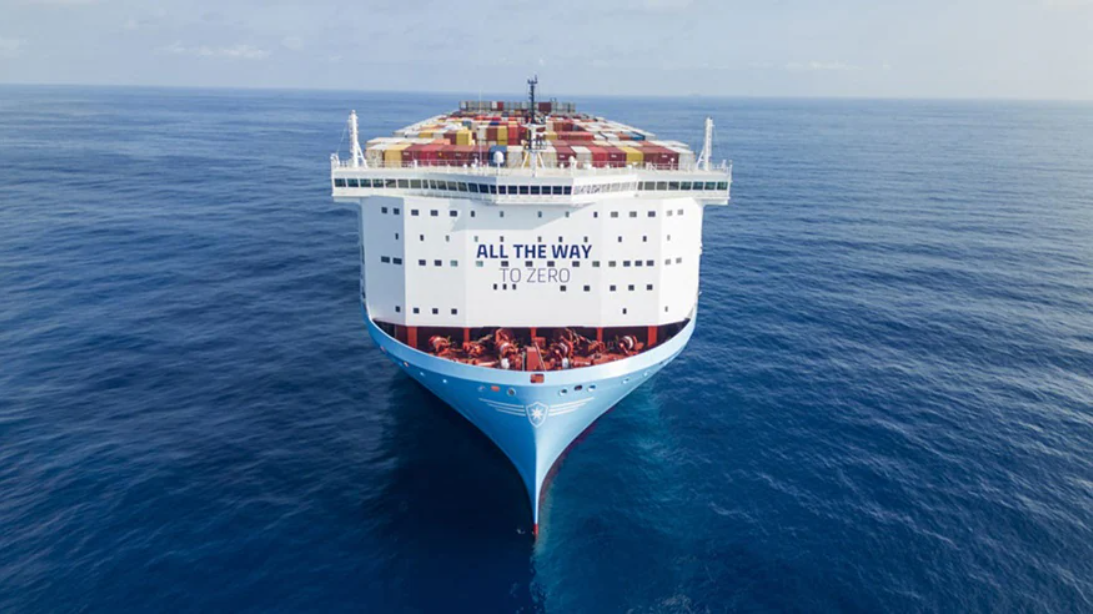
Maersk plans to reduce Scope 1 and 2 emissions by 96% and Scope 3 emissions by 90% by 2040. (Photo: Maersk)
The shipping industry is facing immense pressure to reduce emissions due to underdeveloped decarbonization technologies and tightening carbon tax policies. Major players like Maersk and Taiwan’s top shipping companies—Evergreen, Wan Hai, and Yang Ming—are adopting sustainable fuels and onboard carbon capture (OCC) technologies to meet these challenges.
As companies push towards net zero emissions, the focus is increasingly shifting to Scope 3 emissions, which are closely linked to the supply chain. According to the Carbon Disclosure Project (CDP), Scope 3 emissions account for an average of 75% of total emissions across industries. Particularly notable is the carbon footprint from the transportation and distribution of products, with international shipping emissions rising by 5% in 2022, nearing pre-pandemic levels.
Green logistics market to reach $350 billion by 2030
A survey by McKinsey on 250 global freight companies and suppliers reveals a growing shift towards green logistics. Over 70% of respondents expressed willingness to pay a premium for greener shipping solutions, driven by consumer demand for reduced carbon footprints. McKinsey projects that the green logistics market will reach $350 billion by 2030, accounting for 15% of global logistics expenditure.
Figure 1
The technology sector is expected to contribute the most, with $111 billion, followed by consumer retail, manufacturing, healthcare, and fossil fuels. However, there is a stark contrast between the willingness to reduce carbon emissions and actual implementation, with only a quarter of companies confident in their decarbonization goals.
Figure 2
The report identifies three major obstacles to decarbonizing logistics:
- Lack of standardized solutions: The lack of high-quality, universally applicable low-carbon shipping solutions discourages investment in new technologies.
- Uncertainty of new technologies: The challenges include not only costs but also the scalability of innovations and the disposal of surplus assets.
- Corporate hesitancy: Many low-carbon logistics technologies are not yet scalable, such as sustainable fuels and charging infrastructure, hindering business investment decisions.
Green fuel supply constraints, international policies increase decarbonization pressure
Despite initial reports not distinguishing between maritime, land, and air transport challenges, maritime shipping, which handles about 90% of global trade, is a significant source of carbon emissions, accounting for nearly 3% of global emissions.
The industry relies on fossil fuels for 99% of its electricity demand, with no large-scale sustainable fuel alternatives currently available, exacerbating the pressure for decarbonization, especially with growing international requirements.
In March 2024, the International Maritime Organization (IMO) held a meeting where 34 countries supported a global greenhouse gas emissions tax for the shipping industry. The IMO is drafting details for this tax, which, if approved, will come into effect in 2027, marking the first global carbon pricing scheme.
The IMO adopted revised guidelines in July 2023 with the goal of achieving net-zero emissions by 2050, which is stricter than the 2018 version, with milestones including a 30% reduction by 2030 and 80% by 2040 compared to 2008 levels. However, there are still significant disagreements among countries regarding pricing standards and tax applications.
The EU Emissions Trading System (ETS) included shipping from April 2023, requiring ships over 5,000 gross tonnages to purchase emission allowances for 40% of their emissions starting in 2024, increasing to 100% by 2026.
The European Council also passed the FuelEU Maritime regulation in July 2023, mandating the shipping industry to reduce carbon emissions by 2% from 2025 compared to 2020 levels, with an 80% reduction target by 2050. This regulation applies to vessels over 5,000 gross tonnages, which represent 55% of the fleet and account for 90% of carbon emissions.
Shipping giants tackling decarbonization through low-carbon fuels, energy efficiency
Global shipping leader Maersk is widely recognized for its ambitious decarbonization efforts, with its greenhouse gas reduction targets verified by the Science Based Targets initiative (SBTi), making it the first to achieve certification under the new maritime guidelines.
Maersk used green fuels to transport 660,000 TEUs in 2023, a 37% increase from the previous year, reducing emissions by 683,000 tonnes.
Maersk's goals include a 35% reduction in Scope 1 emissions by 2030 and a dramatic acceleration of reductions by 2040, targeting a 96% decrease in Scope 1 and 2 emissions and a 90% reduction in Scope 3 emissions.
Green methanol and biodiesel are expected to play crucial roles, with the launch of the world’s first large methanol-powered container ship, "Ane Maersk," marking a significant step in expanding their green fleet.
Taiwanese shipping giants Evergreen, Wan Hai, and Yang Ming are also advancing their sustainability efforts.
Yang Ming has begun using biofuels for its fleet, with its vessel "YM Together" being the first foreign ship in South Korea to use biofuels.
Evergreen is investing in methanol-powered ships and containers, aiming to reduce carbon credit purchases through long-term energy-efficient vessel strategies.
Wan Hai has launched limited-time carbon-neutral routes, encouraging customers to support environmental initiatives, and is among the first buyers of carbon credits from Taiwan’s carbon exchange.
International shipping remains one of the hardest-to-abate and carbon-intensive industries. In addition to low-carbon fuels, the industry is also exploring onboard carbon capture technology (OCC).
As green fuels become more costly, technologies that allow the use of traditional fuels while reducing emissions may stand out in the future, offering a promising path to accelerate decarbonization goals.
Source: CDP, McKinsey & Company, IEA, Sustainability Magazine, DVN







